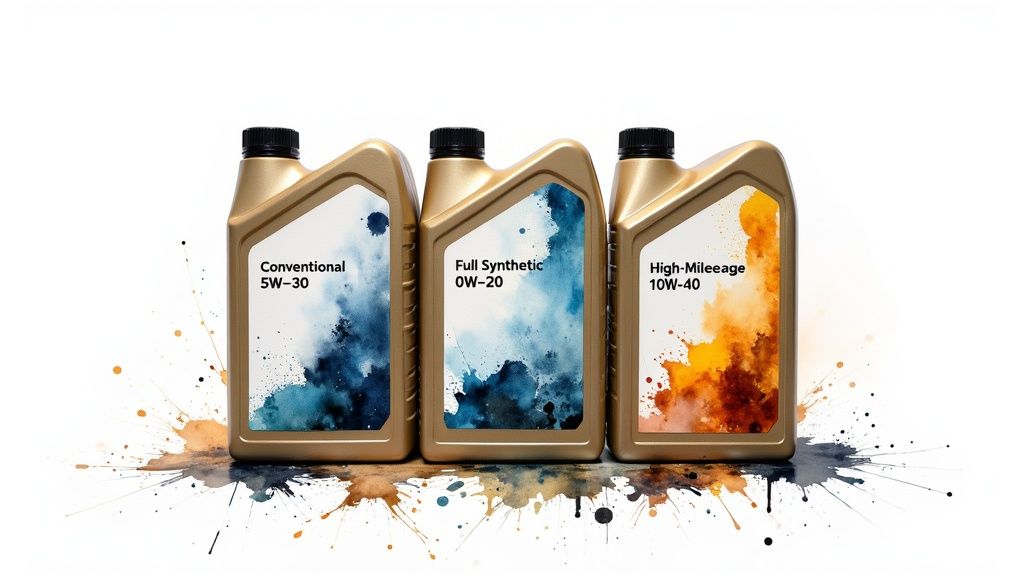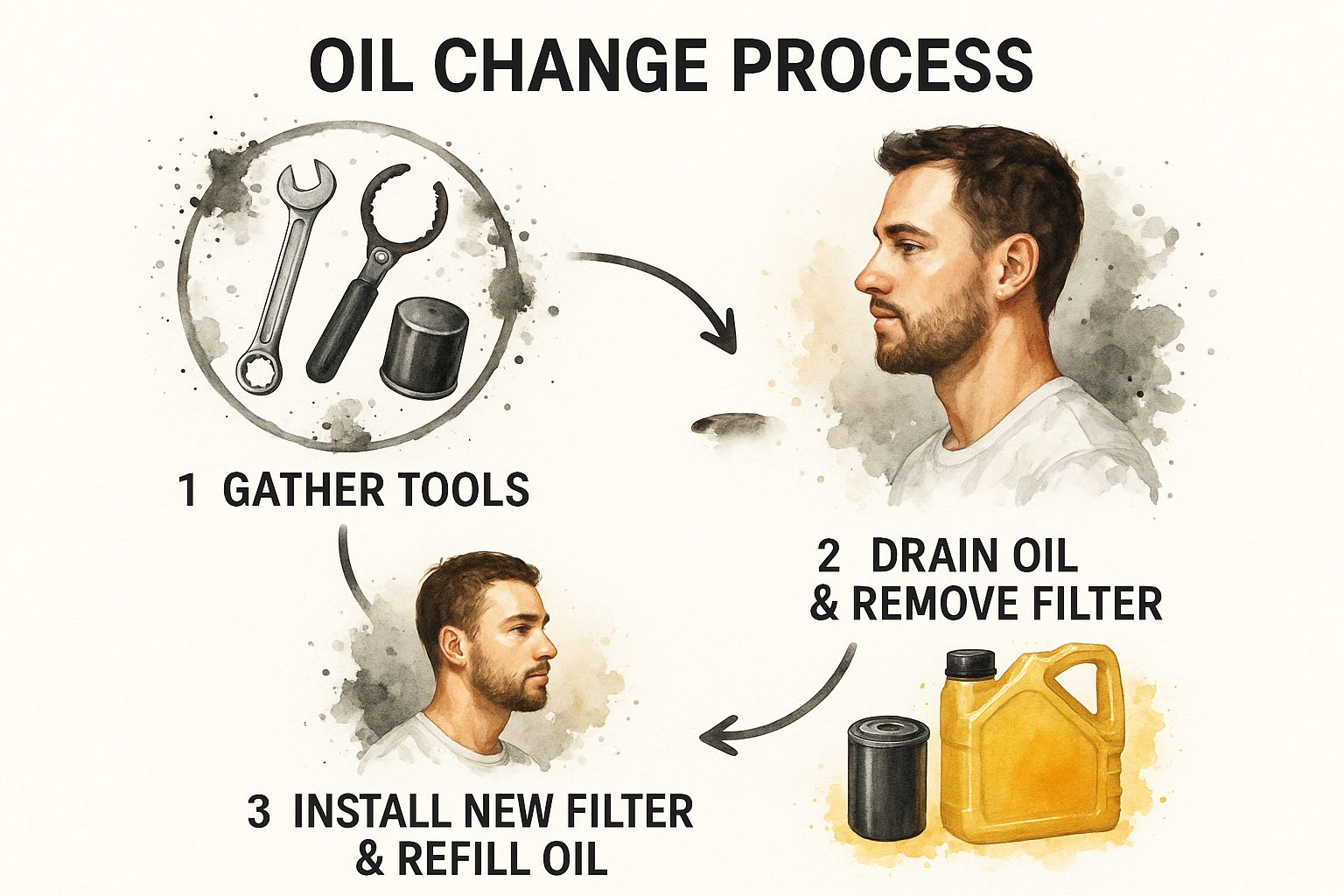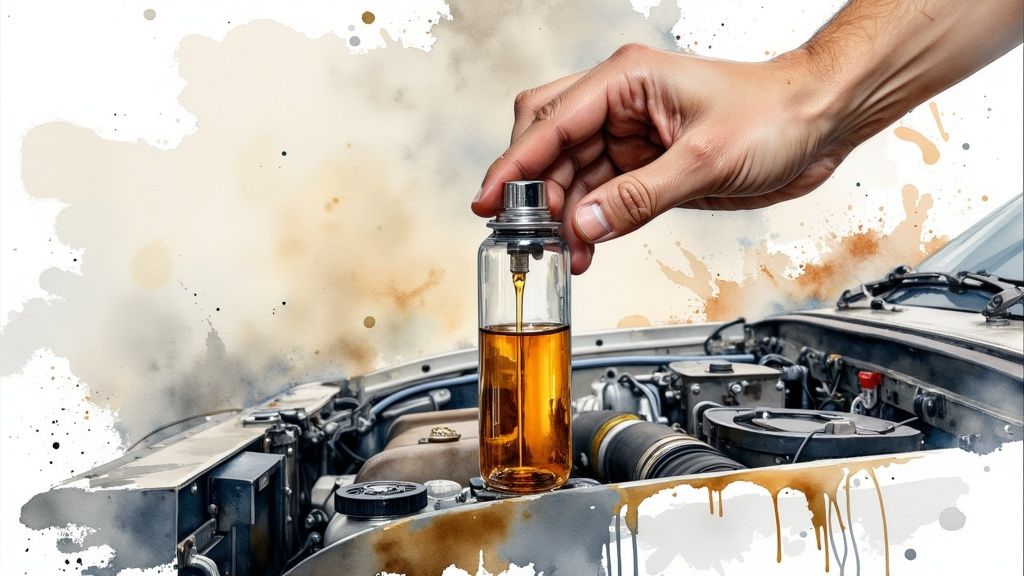Keep Your Engine Happy: Essential Oil Change Tips
Regular oil changes are vital for a healthy engine and can prevent costly repairs. This listicle provides six actionable oil change tips to maximize your vehicle's performance and longevity. Learn how to determine your car's oil change interval, select the correct oil type, dispose of used oil properly, perform a DIY oil change, choose a quality oil filter, and monitor your oil between changes. These oil change tips will help keep your engine running smoothly whether you're in Haltom City, Keller, Watauga, or North Richland Hills, TX.
1. Know Your Vehicle's Oil Change Interval
One of the most fundamental oil change tips is understanding your vehicle's specific oil change interval. This knowledge is crucial for proper engine maintenance and can save you money in the long run. Gone are the days of the ubiquitous 3,000-mile oil change. Modern vehicles, with advancements in engine technology and oil formulations, often have significantly longer recommended intervals. Many newer models only require oil changes every 7,500-10,000 miles, or even longer. Learn more about Know Your Vehicle's Oil Change Interval
This interval isn't arbitrary; it's carefully determined by the manufacturer based on several factors, including engine design, recommended oil type (conventional, synthetic blend, or full synthetic), and typical driving conditions. Adhering to this schedule ensures your engine receives proper lubrication and protection, maximizing its lifespan and performance.
How does it work?
Your vehicle's recommended oil change interval is outlined in your owner's manual. This manual is the ultimate guide to maintaining your specific make and model. Some newer vehicles also feature oil monitoring systems that analyze driving patterns and oil condition to calculate personalized change intervals. These systems take into account factors like engine temperature, mileage, and driving style to provide a more accurate assessment of when an oil change is needed.
Examples of Successful Implementation:
- Toyota Camry (2020 models): Recommend oil changes every 10,000 miles with full synthetic oil.
- BMW: Many models include oil monitoring systems that dynamically calculate change intervals based on driving data.
- Ford F-150: Typically require oil changes every 7,500-10,000 miles under normal driving conditions.
Pros of Knowing Your Interval:
- Prevents unnecessary oil changes and waste: Sticking to the recommended interval avoids prematurely discarding perfectly good oil, which is good for both your wallet and the environment.
- Saves money over time: Fewer oil changes mean lower overall maintenance costs.
- Properly maintains engine according to engineering specifications: Following the manufacturer’s guidelines ensures optimal engine performance and longevity.
- Modern oils are designed for longer service life: Synthetic and synthetic blend oils can withstand higher temperatures and maintain their lubricating properties for longer periods than conventional oils.
Cons to Consider:
- Requires careful tracking of mileage: You'll need to keep track of your mileage between oil changes, especially if your vehicle doesn't have an oil monitoring system.
- Severe driving conditions may necessitate more frequent changes: If you frequently drive in stop-and-go traffic, extreme temperatures, or dusty environments, you may need to change your oil more often than the standard interval.
- Oil monitoring systems can occasionally malfunction: While generally reliable, these systems can sometimes provide inaccurate readings.
Actionable Oil Change Tips:
- Consult your owner's manual: This is the best source for your vehicle's specific oil change interval.
- Consider more frequent changes for severe driving conditions: Short trips, extreme temperatures, and dusty environments put more stress on your engine oil.
- Maintain a maintenance log: Keep a record of your oil changes in your glove compartment.
- Don't rely solely on oil change stickers: Quick lube shops may use generic intervals that don't align with your vehicle's specific needs.
Changing your oil regularly is crucial, but it's also important to budget for it. Understanding the factors that influence oil change prices can help you make informed decisions. You can learn more about how much an oil change costs. By understanding and adhering to the recommended oil change interval for your vehicle, you're taking a proactive step towards ensuring its long-term health and performance, which is a key component of effective oil change tips.
2. Choose the Right Oil Type
One of the most crucial oil change tips is selecting the correct oil type for your vehicle. This isn't just about grabbing any bottle off the shelf; it directly impacts your engine's performance, longevity, and even your fuel economy. Different oil types offer varying levels of protection and performance. Making the right choice ensures your engine runs smoothly and efficiently for years to come. This involves understanding oil classifications (conventional, synthetic blend, full synthetic, and high-mileage), viscosity ratings (like 5W-30 or 0W-20), and manufacturer-specific approvals.

Understanding Oil Classifications and Viscosity:
- Conventional Oil: A good all-around option for vehicles with standard engine designs and driving conditions. It's the most affordable choice but requires more frequent changes.
- Synthetic Blend: Offers enhanced protection and performance compared to conventional oil, bridging the gap between conventional and full synthetic options.
- Full Synthetic Oil: Engineered for superior performance in extreme temperatures, offering maximum protection against wear and tear. It also allows for extended oil change intervals. Products like Mobil 1 Extended Performance Full Synthetic can even provide protection for up to 20,000 miles in some applications, showcasing the advancement of synthetic technology. Pennzoil Ultra Platinum, crafted with their PurePlus Technology, converts natural gas into a pure synthetic base oil, another example of innovation in this category.
- High-Mileage Oil: Formulated with special additives to address the specific needs of older engines with higher mileage, typically over 75,000 miles. Valvoline High Mileage with MaxLife Technology is a popular example, designed to combat leaks and reduce oil consumption in aging engines.
Why the Right Oil Matters: Using the correct oil viscosity, as recommended by your vehicle's manufacturer, is vital for maintaining proper lubrication and engine protection across all temperatures. Using the wrong viscosity can lead to decreased fuel economy, increased engine wear, and even void your warranty. While synthetic oils like those from Mobil 1, Pennzoil, Castrol, Royal Purple, and Valvoline offer superior performance, particularly in extreme conditions, they come at a higher cost. Additionally, some older vehicles may not be compatible with modern low-viscosity oils, so consulting your owner's manual is paramount.
Actionable Oil Change Tips:
- Consult Your Owner's Manual: This is the ultimate guide for your specific vehicle's oil requirements. It will provide the recommended oil type, viscosity grade, and any manufacturer-specific approvals.
- Consider Upgrading to Synthetic: For enhanced protection and longer change intervals, synthetic oil is a worthwhile investment.
- Transition to High-Mileage: Once your vehicle surpasses 75,000 miles, switching to a high-mileage formulation can help address age-related engine issues.
- Maintain Consistency: Sticking with the same oil type between changes ensures consistent performance and protection.
- Factor in Climate: Thinner oils (lower viscosity) are better suited for cold climates, while thicker oils (higher viscosity) perform better in hot conditions.
Learn more about Choose the Right Oil Type
This oil change tip deserves its place on the list because choosing the right oil is fundamental to engine health and longevity. By understanding the different types of oil, their benefits, and how to select the right one for your vehicle, drivers in Haltom City, Keller, Watauga, and North Richland Hills, TX, can ensure optimal performance, protect their investment, and enjoy a smoother, more efficient driving experience. Whether you're a busy professional, a fleet manager, or a safety-conscious driver, choosing the right oil is a simple yet powerful way to maintain your vehicle.
3. Proper Oil Disposal and Recycling
One of the most important oil change tips, often overlooked, is the proper disposal and recycling of used motor oil. This crucial step is not only good for the environment but is also legally required in most areas. Improper disposal can contaminate water supplies and soil, posing significant environmental risks. Recycling used oil, on the other hand, allows it to be re-refined into new oil products or used as fuel, reducing waste and conserving valuable resources. This makes responsible disposal an essential part of any oil change.

The process of recycling used oil is surprisingly efficient. Companies like Safety-Kleen, the largest collector and re-refiner of used oil in North America, and EcoPower, which produces re-refined motor oil, utilize sophisticated re-refining processes that clean the used oil and transform it into usable products. This process uses significantly less energy than producing virgin oil, further contributing to its environmental benefits. Moreover, the EPA's Used Oil Management Program and the American Petroleum Institute's "Recycle Oil" program offer resources and guidelines for proper disposal and recycling. The EPA regulates used oil disposal to minimize environmental impact and protect public health.
One of the significant benefits of recycling is its impact on water conservation. Just one gallon of used oil can contaminate one million gallons of fresh water. By properly disposing of and recycling your used oil, you are playing a vital role in protecting our precious water resources. Furthermore, recycling your used oil requires less energy to produce than virgin oil, making it a more sustainable choice. Many locations that accept used oil also accept oil filters for recycling, providing a comprehensive solution for responsible disposal after an oil change.
While the benefits of recycling are clear, there are a few practical considerations. You'll need to store your used oil in a clean container with a tight-fitting lid until you can take it to a recycling center. Some remote areas may have limited recycling options, requiring some research to find the nearest drop-off point. Also, if your used oil is contaminated with other fluids like coolant or gasoline, it may require special disposal procedures. Contact your local hazardous waste collection service for guidance in such cases.
Tips for Proper Oil Disposal and Recycling:
- Drain oil into a clean container with a tight-fitting lid: This prevents spills and contamination.
- Never mix used oil with other fluids: This can complicate the recycling process.
- Call ahead to verify acceptance policies: Different recycling locations may have specific requirements. Auto parts stores like AutoZone, Advance Auto Parts, and O'Reilly generally accept used oil for free recycling, but it's always best to confirm.
- Use a funnel when transferring: This minimizes the risk of spills.
- Bring oil filters (properly drained) for recycling as well: Many locations accept both used oil and oil filters.
- Keep receipts from recycling centers: This may be required by local regulations.
Proper oil disposal and recycling is a vital component of responsible vehicle maintenance and deserves its place on this list of oil change tips. By following these simple guidelines, residents of Haltom City, Keller, Watauga, and North Richland Hills, TX, along with anyone performing an oil change, can contribute to a cleaner environment and conserve valuable resources. This is particularly relevant for busy professionals, fleet managers, and safety-conscious drivers who understand the importance of environmentally sound practices and efficient maintenance.
4. DIY Oil Change Best Practices
Performing your own oil change can be a rewarding experience, saving you money and giving you a deeper understanding of your vehicle's maintenance. A proper DIY oil change, however, involves more than just draining and refilling. It requires attention to safety, proper tool usage, correct disposal of used oil, and thorough documentation for your vehicle’s service history. This approach empowers you to take control of your vehicle's maintenance and ensures the job is done right.

The infographic below details the step-by-step process for a DIY oil change.

The infographic clearly outlines the key steps in a DIY oil change, emphasizing safety and proper procedures. It highlights the importance of preparing the vehicle, draining the old oil completely, and correctly installing the new filter. Following this process ensures a successful and mess-free oil change.
A successful DIY oil change hinges on having the right tools and following the correct procedure. You'll need a wrench/socket set (sized for your vehicle’s drain plug), an oil filter wrench, a drain pan, jack stands, and wheel chocks. Safety is paramount; always ensure your vehicle is securely supported on jack stands before working underneath it. Learn more about DIY Oil Change Best Practices for detailed guidance. For residents of Haltom City, Keller, TX, Watauga, TX, and North Richland Hills, TX, taking control of your vehicle maintenance can be especially beneficial, offering cost savings and peace of mind.
Here's a breakdown of the process and some helpful oil change tips:
- Gather your supplies: Ensure you have the correct type and amount of oil for your vehicle, a new oil filter, the necessary tools, and a container for the used oil.
- Prepare your vehicle: Warm up the engine for a few minutes to help the oil drain more easily. Then, securely position your vehicle on jack stands and engage the parking brake.
- Locate the drain plug and oil filter: Consult your owner's manual if necessary. Position the drain pan beneath the drain plug.
- Drain the old oil: Carefully remove the drain plug and allow the oil to drain completely.
- Replace the oil filter: Remove the old filter, ensuring the old gasket doesn't stick to the engine. Lubricate the gasket of the new filter with fresh oil and install it according to the manufacturer's instructions. Using a torque wrench is recommended for the drain plug to avoid stripping.
- Refill with new oil: Once the old oil has drained, replace the drain plug, tightening it to the proper torque specification. Add the correct amount of new oil, checking the dipstick regularly.
- Check for leaks: After refilling, run the engine for a few minutes and check for any leaks around the drain plug and oil filter.
- Dispose of used oil properly: Take the used oil to a designated recycling center or auto parts store.
Check out this video for a visual guide to changing your oil. Channels like ChrisFix, Scotty Kilmer, and EricTheCarGuy are excellent resources for visual learners.
Pros:
- Cost Savings: DIY oil changes can save you $20-$50 or more per change compared to service centers.
- Quality Control: You have complete control over the quality of the oil and filter used.
- Vehicle Inspection: While under your vehicle, you can inspect other components for potential issues.
- Skill Development: You gain valuable vehicle maintenance skills.
Cons:
- Initial Investment: You'll need to invest in tools and equipment.
- Risk of Injury: Improperly supporting the vehicle can lead to injury.
- Messy Spills: Without proper technique, spills can occur.
- Time Investment: A DIY oil change can take 30-60 minutes, especially for beginners.
This DIY approach deserves a place on this list because it empowers vehicle owners. It offers tangible benefits like cost savings and quality control while promoting a deeper understanding of vehicle maintenance. Whether you’re a busy professional, a fleet manager, or simply a safety-conscious driver, mastering the DIY oil change offers numerous advantages. Innovative solutions like Fumoto drain valves can further simplify the process, making it cleaner and more efficient.
5. Understand Oil Filter Quality Differences
When discussing oil change tips, the importance of oil filter quality often gets overlooked. While you're focused on selecting the right oil, remember that the filter plays a crucial role in keeping that oil clean and your engine running smoothly. This step is vital for all vehicle owners in areas like Haltom City, Keller, Watauga, and North Richland Hills, TX, ensuring your car performs optimally in our local conditions. Understanding filter differences can significantly impact your engine’s health and longevity, whether you're a busy professional, fleet manager, or simply a safety-conscious driver.
The oil filter's job is to remove contaminants like dirt, metal particles, and combustion byproducts from your engine oil. These contaminants can cause premature wear and tear on engine components, leading to costly repairs down the line. Filters achieve this through various internal components and materials, and their effectiveness varies significantly based on their quality.
How Oil Filters Work and Why Quality Matters:
Oil filters work by forcing oil through a filter media. This media traps contaminants while allowing clean oil to pass through. The quality of this media, along with other filter components, determines how effectively the filter performs. Key features impacting filter quality include:
- Filter Media Types: Cellulose filters are basic and cost-effective, but synthetic and hybrid media options offer superior filtration and longer lifespans.
- Micron Ratings: This rating indicates the size of particles a filter can trap. Lower micron ratings mean the filter can capture smaller particles, providing better protection. Premium filters can filter particles down to 20 microns or smaller, compared to 40+ microns for basic filters.
- Bypass Valve: This valve opens when the filter becomes clogged, allowing oil to bypass the filter media and still lubricate the engine. A well-designed bypass valve is crucial for preventing oil starvation during cold starts or when a filter is excessively dirty.
- Anti-Drainback Valve: This valve prevents oil from draining back into the oil pan when the engine is off, ensuring immediate lubrication upon startup. Silicone anti-drainback valves are more durable and longer-lasting than rubber ones.
Pros of High-Quality Oil Filters:
- Superior Filtration: Premium filters capture more contaminants, leading to cleaner oil and reduced engine wear.
- Maintained Flow Rates: Higher-quality filters maintain optimal oil flow even as they accumulate contaminants.
- Extended Lifespans: Some premium filters are designed for extended oil change intervals, saving you time and money.
- Enhanced Engine Protection: Better bypass valve designs provide superior protection during cold starts.
Cons of High-Quality Oil Filters:
- Higher Cost: Premium filters typically cost 2-3 times more than basic options.
- Marketing Hype: Some manufacturers’ performance claims may be exaggerated.
- Difficult Verification: It can be challenging for consumers to independently verify manufacturer specifications.
Examples of Premium Oil Filters:
- Royal Purple Extended Life: These filters use 100% synthetic media and are rated for 12,000 miles.
- Mobil 1 Extended Performance: Designed for 15,000-mile intervals with 99.6% efficiency.
- Wix XP: Synthetic media filters offering better flow characteristics and contaminant capacity.
Actionable Oil Filter Tips for Your Next Oil Change:
- Match Filter to Oil and Interval: If you’re using synthetic oil and extended oil change intervals, choose a high-quality, extended-life filter.
- Use Manufacturer Recommendations: Consult your vehicle’s owner's manual for recommended filter specifications.
- Consider Brand-Name Filters: Reputable brands often offer better quality control than generic alternatives.
- Look for Silicone Anti-Drainback Valves: These are more durable than rubber valves.
- Keep Receipts: Retain your receipts for warranty purposes.
By understanding oil filter quality differences and following these oil change tips, you can make informed decisions to protect your engine and extend its lifespan. This seemingly small detail can make a significant difference in your vehicle's long-term performance and reliability, especially for drivers in the demanding conditions of North Texas.
6. Monitor Oil Level and Condition Between Changes
Regularly monitoring your oil level and condition is a crucial oil change tip, even between scheduled oil changes. This simple yet powerful practice can help identify potential engine problems early on, saving you from costly repairs and extending the life of your vehicle. Modern engines, even those properly maintained, can consume oil as part of their normal operation. Factors like driving style, environmental conditions, and engine age can also influence oil degradation. By regularly checking your oil, you're taking a proactive step in protecting your investment. This proactive check allows you to catch potential problems before they escalate into major issues.

Checking your oil involves more than just looking at the level on the dipstick. It's also about assessing the oil's condition. Understanding the dipstick markings and employing the correct reading technique is essential. The color of the oil can tell a story: amber to dark brown is generally considered normal, while significantly darker or milky oil could indicate problems. Similarly, a burnt smell suggests overheating, and a gritty texture points towards contamination. These simple observations can provide invaluable insights into the health of your engine.
Examples of Oil Consumption in Specific Vehicles:
- BMW N52 engines: Known for oil consumption rates up to 1 quart per 1,000 miles, which is considered within the normal operating range.
- Subaru boxer engines (particularly 2010-2014 models): Often exhibit higher than average oil consumption.
- Toyota: Employs sophisticated maintenance reminder systems that incorporate oil degradation algorithms.
Pros of Regular Oil Monitoring:
- Early detection of consumption issues: Prevents running critically low on oil.
- Identification of potential mechanical problems: A milky appearance can indicate a coolant leak, while dark, gritty oil might suggest excessive engine wear.
- Prevention of engine damage: Ensures adequate lubrication, protecting vital engine components.
- Extended engine life: Proactive maintenance leads to a longer-lasting engine.
Cons of Regular Oil Monitoring:
- Dipstick design: Some modern vehicles have poorly designed dipsticks or rely solely on electronic monitoring systems, making manual checks more challenging.
- Limitations of visual assessment: Some problems might not be detectable through visual inspection alone.
- Requires consistent habits: Forgetting to check your oil regularly negates the benefits.
Actionable Tips for Monitoring Your Oil:
- Frequency: Check your oil level every 2-4 weeks or before any long trips.
- Engine Temperature: Always check when the engine is cold or after it has been sitting for at least 10 minutes to allow the oil to settle in the oil pan for an accurate reading.
- Level Ground: Park on a level surface for accurate dipstick readings.
- Dipstick Procedure: Wipe the dipstick clean, reinsert it fully, then remove it again to take a reading.
- Keep Spare Oil: Store a quart of your vehicle's specified oil in the trunk for top-offs.
- Consult a Mechanic: If oil consumption exceeds 1 quart per 1,000 miles, consult a qualified mechanic.
- Documentation: Track your oil consumption over time to identify any concerning trends.
This oil change tip is invaluable for all vehicle owners in Haltom City, Keller, Watauga, and North Richland Hills, TX, whether you're seeking routine maintenance, major repairs, or simply want peace of mind knowing your vehicle is in top condition. For busy professionals, fleet managers, and safety-conscious drivers, this simple check can prevent significant problems and ensure optimal engine performance.
6 Essential Oil Change Tips Comparison
| Tip Title | Implementation Complexity 🔄 | Resource Requirements 💡 | Expected Outcomes 📊 | Ideal Use Cases 💡 | Key Advantages ⭐ |
|---|---|---|---|---|---|
| Know Your Vehicle's Oil Change Interval | Low – requires tracking mileage | Minimal – manual tracking or vehicle monitoring | Prevents unnecessary oil changes, cost savings | Vehicle owners aiming for optimal maintenance | Saves money, prevents waste, follows manufacturer specs |
| Choose the Right Oil Type | Medium – requires knowledge of oil types | Moderate – may require purchasing specific oils | Improved engine protection and performance | Drivers selecting oil based on vehicle and climate | Better fuel economy, engine longevity, optimal protection |
| Proper Oil Disposal and Recycling | Low – involves proper disposal | Minimal – access to recycling locations | Environmental protection, legal compliance | All vehicle owners concerned with environmental impact | Prevents pollution, reduces waste, conserves resources |
| DIY Oil Change Best Practices | High – requires tools and skill | High – tools, safety equipment, time investment | Cost savings, improved maintenance skills | DIY enthusiasts, cost-conscious vehicle owners | Saves money, control over parts, skill development |
| Understand Oil Filter Quality Differences | Medium – requires filter knowledge | Moderate – purchase of quality filters | Better engine protection, longer filter service life | Those extending oil change intervals or using synthetic oils | Enhanced engine protection, longer filter life |
| Monitor Oil Level and Condition Between Changes | Low – routine checks | Minimal – dipstick and observation | Early problem detection, prevention of engine damage | All vehicle owners wanting proactive maintenance | Detects issues early, extends engine life, prevents damage |
Ready to Change Your Oil Like a Pro?
This collection of oil change tips empowers you to keep your engine running smoothly and efficiently. From understanding your vehicle's specific oil change interval and choosing the correct oil type to properly disposing of used oil and recognizing the importance of a quality oil filter, these insights are crucial for extending your vehicle's lifespan. Regularly monitoring your oil level and condition between changes, as discussed above, allows you to catch potential issues early and prevent costly repairs down the road. Mastering these simple yet effective oil change tips translates directly to better engine performance, improved fuel efficiency, and significant long-term savings. This is a valuable investment, whether you're a busy professional in Keller, TX, a fleet manager in North Richland Hills, TX, a safety-conscious driver in Watauga, TX, or simply a Haltom City resident looking to keep their car in top shape.
For those who prefer the expertise of certified technicians and the convenience of fast, reliable service, Express Lube & Car Care in Haltom City, Texas, offers comprehensive oil change services using premium parts. Schedule your next oil change with Express Lube & Car Care today and experience the difference that professional care can make for your vehicle: Express Lube and Car Care




